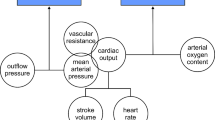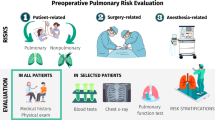Abstract
The elderly population is rapidly growing and particularly diverse. Ageing leads to reduced organ function and a decline in physiologic reserve. Elderly patients are characterised by great inter-individual variability in physiological function with a high prevalence of chronic disease. In general, older patients have a higher risk of postoperative adverse outcomes, and frailty is a very important risk factor. This review article aims to provide a practical guide to anaesthetic management of the elderly surgical patient. To optimise care, clinicians should be familiar with the typical physiologic changes related to ageing and the implications for anaesthetic management. All anaesthetic techniques, methods and agents can be applied, if tailored to the patient’s physiologic and pathologic changes. The elderly are more sensitive to anaesthetics, meaning that desired sedative and analgesic effects are reached at lower doses compared with younger patients, and the haemodynamic depressing side effects of anaesthetics are often more pronounced. To reduce the risk of circulatory collapse, the clinician should carefully titrate anaesthetics and await the response with patience. The dose of neuromuscular blocking agents should rarely be reduced for intubation, but the duration of action of neuromuscular blocking agents is often prolonged and difficult to predict. Perioperative neuromuscular monitoring is therefore strongly recommended. In the postoperative period, prevention of avoidable morbidity and functional decline is crucial; comprehensive multidisciplinary care and multimodal interventions may facilitate earlier recovery and decrease the risk of complications.

Similar content being viewed by others
References
Clegg A, Young J, Iliffe S, et al. Frailty in elderly people. Lancet. 2013;381:752–62. doi:10.1016/S0140-6736(12)62167-9.
Aunan JR, Watson MM, Hagland HR, Søreide K. Molecular and biological hallmarks of ageing. Br J Surg. 2016;103:e29–46. doi:10.1002/bjs.10053.
Moller J, Cluitmans P, Rasmussen L, et al. Long-term postoperative cognitive dysfunction in the elderly: ISPOCD1 study. Lancet. 1998;351:857–61. doi:10.1016/S0140-6736(97)07382-0.
Fried LP, Tangen CM, Walston J, et al. Frailty in older adults: evidence for a phenotype. J Gerontol A Biol Sci Med Sci. 2001;56:M146–56.
Oakland K, Nadler R, Cresswell L, et al. Systematic review and meta-analysis of the association between frailty and outcome in surgical patients. Ann R Coll Surg Engl. 2016;8:80–5. doi:10.1308/rcsann.2016.0048.
Brody KK, Johnson RE, Douglas Ried L. Evaluation of a self-report screening instrument to predict frailty outcomes in aging populations. Gerontologist. 1997;37:182–91.
Oresanya LB, Lyons WL, Finlayson E. Preoperative assessment of the older patient: a narrative review. JAMA. 2014;311:2110–20. doi:10.1001/jama.2014.4573.
Makary MA, Segev DL, Pronovost PJ, et al. Frailty as a predictor of surgical outcomes in older patients. J Am Coll Surg. 2010;210:901–8. doi:10.1016/j.jamcollsurg.2010.01.028.
Turrentine FE, Wang H, Simpson VB, Jones RS. Surgical risk factors, morbidity, and mortality in elderly patients. J Am Coll Surg. 2006;203:865–77. doi:10.1016/j.jamcollsurg.2006.08.026.
Wolters U, Wolf T, Stützer H, Schröder T. ASA classification and perioperative variables as predictors of postoperative outcome. Br J Anaesth. 1996;77:217–22.
NSQIP/ASC. Risk calculator. http://riskcalculator.facs.org/RiskCalculator. Accessed 4 Oct 2016.
The Criteria Committee of the New York Heart Association. Nomenclature and criteria for diagnosis of diseases of the heart and great vessels. 9th ed. Boston: Little, Brown & Co.; 1994. pp. 253–6.
Campeau L. Letter: grading of angina pectoris. Circulation. 1976;54:522–3.
Monk TG, Weldon BC, Garvan CW, et al. Predictors of cognitive dysfunction after major noncardiac surgery. Anesthesiology. 2008;108:18–30. doi:10.1097/01.anes.0000296071.19434.1e.
Borson S, Scanlan J, Brush M, et al. The mini-cog: a cognitive “vital signs” measure for dementia screening in multi-lingual elderly. Int J Geriatr Psychiatry. 2000;15:1021–7.
Barry PJ, Gallagher P, Ryan C, O’Mahony D. START (screening tool to alert doctors to the right treatment): an evidence-based screening tool to detect prescribing omissions in elderly patients. Age Ageing. 2007;36:632–8. doi:10.1093/ageing/afm118.
Liu LL, Dzankic S, Leung JM. Preoperative electrocardiogram abnormalities do not predict postoperative cardiac complications in geriatric surgical patients. J Am Geriatr Soc. 2002;50:1186–91.
Dzankic S, Pastor D, Gonzalez C, Leung JM. The prevalence and predictive value of abnormal preoperative laboratory tests in elderly surgical patients. Anesth Analg. 2001;93:301–8, 2nd contents page.
Beers MH. Explicit criteria for determining potentially inappropriate medication use by the elderly: an update. Arch Intern Med. 1997;157:1531–6. doi:10.1001/archinte.157.14.1531.
O’Mahony D, Gallagher P, Ryan C, et al. STOPP & START criteria: a new approach to detecting potentially inappropriate prescribing in old age. Eur Geriatr Med. 2010;1:45–51. doi:10.1016/j.eurger.2010.01.007.
Douketis JD, Spyropoulos AC, Spencer FA, et al. Perioperative management of antithrombotic therapy: antithrombotic therapy and prevention of thrombosis. 9th ed. American College of Chest Physicians Evidence-Based Clinical Practice Guidelines. Chest. 2012;141:e326S–50S. doi:10.1378/chest.11-2298.
Spyropoulos AC. Bridging therapy and oral anticoagulation: current and future prospects. Curr Opin Hematol. 2010;17:444–9. doi:10.1097/MOH.0b013e32833c077b.
Tumer N, Scarpace PJ, Lowenthal DT. Geriatric pharmacology: basic and clinical considerations. Annu Rev Pharmacol Toxicol. 1992;32:271–302. doi:10.1146/annurev.pa.32.040192.001415.
Spanjersberg WR, Reurings J, Keus F, van Laarhoven CJ. Fast track surgery versus conventional recovery strategies for colorectal surgery. Cochrane Database Syst Rev; 2011;(2):CD007635. doi:10.1002/14651858.CD007635.pub2.
Wind J, Polle SW, Fung Kon Jin PHP, et al. Systematic review of enhanced recovery programmes in colonic surgery. Br J Surg. 2006;93:800–9. doi:10.1002/bjs.5384.
Bagnall NM, Malietzis G, Kennedy RH, et al. A systematic review of enhanced recovery care after colorectal surgery in elderly patients. Colorectal Dis. 2014;16:947–56. doi:10.1111/codi.12718.
Khan MA, Pandey S. Clinical outcomes of the very elderly undergoing enhanced recovery programmes in elective colorectal surgery. Ann R Coll Surg Engl. 2016;98:29–33. doi:10.1308/rcsann.2015.0036.
Rasmussen LS, Johnson T, Kuipers HM, et al. Does anaesthesia cause postoperative cognitive dysfunction? A randomised study of regional versus general anaesthesia in 438 elderly patients. Acta Anaesthesiol Scand. 2003;47:260–6.
Wu CL, Hsu W, Richman JM. Raja SN Postoperative cognitive function as an outcome of regional anesthesia and analgesia. Reg Anesth Pain Med. 2004;29:257–68.
Guay J, Choi PT, Suresh S, et al. Neuraxial anesthesia for the prevention of postoperative mortality and major morbidity: an overview of cochrane systematic reviews. Anesth Analg. 2014;119:716–25. doi:10.1213/ANE.0000000000000339.
Chu C-C, Weng S-F, Chen K-T, et al. Propensity score-matched comparison of postoperative adverse outcomes between geriatric patients given a general or a neuraxial anesthetic for hip surgery: a population-based study. Anesthesiology. 2015;123:136–47. doi:10.1097/ALN.0000000000000695.
Guay J, Choi P, Suresh S, et al. Neuraxial blockade for the prevention of postoperative mortality and major morbidity: an overview of Cochrane systematic reviews. Cochrane Database Syst Rev. 2014;(1):CD010108. doi:10.1002/14651858.CD010108.pub2.
Guay J, Parker MJ, Gajendragadkar PR, Kopp S. Anaesthesia for hip fracture surgery in adults. Cochrane Database Syst Rev. 2016;(2):CD000521. doi:10.1002/14651858.CD000521.pub3.
Kazmierski J, Kowman M, Banach M, et al. Incidence and predictors of delirium after cardiac surgery: results from The IPDACS Study. J Psychosom Res. 2010;69:179–85. doi:10.1016/j.jpsychores.2010.02.009.
van Harten AE, Scheeren TWL, Absalom AR. A review of postoperative cognitive dysfunction and neuroinflammation associated with cardiac surgery and anaesthesia. Anaesthesia. 2012;67:280–93. doi:10.1111/j.1365-2044.2011.07008.x.
Hogue CW, Palin CA, Arrowsmith JE. Cardiopulmonary bypass management and neurologic outcomes: an evidence-based appraisal of current practices. Anesth Analg. 2006;103:21–37. doi:10.1213/01.ANE.0000220035.82989.79.
Cusack BJ. Pharmacokinetics in older persons. Am J Geriatr Pharmacother. 2004;2:274–302. doi:10.1016/j.amjopharm.2004.12.005.
Myles PS, Leslie K, Chan MTV, et al. The safety of addition of nitrous oxide to general anaesthesia in at-risk patients having major non-cardiac surgery (ENIGMA-II): a randomised, single-blind trial. Lancet. 2014;384:1446–54. doi:10.1016/S0140-6736(14)60893-X.
Nickalls RWD, Mapleson WW. Age-related iso-MAC charts for isoflurane, sevoflurane and desflurane in man. Br J Anaesth. 2003;91:170–4. doi:10.1093/bja/aeg132.
Schnider TW, Minto CF, Shafer SL, et al. The influence of age on propofol pharmacodynamics. Anesthesiology. 1999;90:1502–16.
Stanski DR, Maitre PO. Population pharmacokinetics and pharmacodynamics of thiopental: the effect of age revisited. Anesthesiology. 1990;72:412–22.
Arden JR, Holley FO, Stanski DR. Increased sensitivity to etomidate in the elderly: initial distribution versus altered brain response. Anesthesiology. 1986;65:19–27.
Reves JG, Fragen RJ, Vinik HR, Greenblatt DJ. Midazolam: pharmacology and uses. Anesthesiology. 1985;62:310–24.
Egan TD, Kern SE, Muir KT, White J. Remifentanil by bolus injection: a safety, pharmacokinetic, pharmacodynamic, and age effect investigation in human volunteers. Br J Anaesth. 2004;92:335–43. doi:10.1093/bja/aeh075.
Minto CF, Schnider TW, Shafer SL. Pharmacokinetics and pharmacodynamics of remifentanil. II. Model application. Anesthesiology. 1997;86:24–33.
Murphy GS, Szokol JW, Avram MJ, et al. Residual neuromuscular block in the elderly: incidence and clinical implications. Anesthesiology. 2015;123:1322–36. doi:10.1097/ALN.0000000000000865.
Arain SR, Kern S, Ficke DJ, Ebert TJ. Variability of duration of action of neuromuscular-blocking drugs in elderly patients. Acta Anaesthesiol Scand. 2005;49:312–5. doi:10.1111/j.1399-6576.2005.00634.x.
Tsui BCH, Wagner A, Finucane B. Regional anaesthesia in the elderly: a clinical guide. Drugs Aging. 2004;21:895–910.
Simon MJG, Veering BT, Stienstra R, et al. Effect of age on the clinical profile and systemic absorption and disposition of levobupivacaine after epidural administration. Br J Anaesth. 2004;93:512–20. doi:10.1093/bja/aeh241.
Racle JP, Benkhadra A, Poy JY, Gleizal B. Spinal analgesia with hyperbaric bupivacaine: influence of age. Br J Anaesth. 1988;60:508–14.
Qureshi SH, Rizvi SI, Patel NN, Murphy GJ. Meta-analysis of colloids versus crystalloids in critically ill, trauma and surgical patients. Br J Surg. 2016;103:14–26. doi:10.1002/bjs.9943.
Guralnik JM, Eisenstaedt RS, Ferrucci L, et al. Prevalence of anemia in persons 65 years and older in the United States: evidence for a high rate of unexplained anemia. Blood. 2004;104:2263–8.
Brunskill SJ, Millette SL, Shokoohi A, et al. Red blood cell transfusion for people undergoing hip fracture surgery. Cochrane Database Syst Rev. 2015;4:CD009699. doi:10.1002/14651858.CD009699.pub2.
Adams SD, Cotton BA, McGuire MF, et al. Unique pattern of complications in elderly trauma patients at a level I trauma center. J Trauma Acute Care Surg. 2012;72:112–8. doi:10.1097/TA.0b013e318241f073.
Kruse-Jarres R. Acquired bleeding disorders in the elderly. Hematology Am Soc Hematol Educ Program. 2015;2015:231–6. doi:10.1182/asheducation-2015.1.231.
Frank SM, Fleisher LA, Breslow MJ, et al. Perioperative maintenance of normothermia reduces the incidence of morbid cardiac events: a randomized clinical trial. JAMA. 1997;277:1127–34.
Renner J, Grünewald M, Bein B, et al. Monitoring high-risk patients: minimally invasive and non-invasive possibilities. Best Pract Res Clin Anaesthesiol. 2016;30:201–16. doi:10.1016/j.bpa.2016.04.006.
Siddiqi N, Harrison JK, Clegg A, et al. Interventions for preventing delirium in hospitalised non-ICU patients. Cochrane Database Syst Rev. 2016;3:CD005563. doi:10.1002/14651858.CD005563.pub3.
Sieber FE, Zakriya KJ, Gottschalk A, et al. Sedation depth during spinal anesthesia and the development of postoperative delirium in elderly patients undergoing hip fracture repair. Mayo Clin Proc. 2010;85:18–26. doi:10.4065/mcp.2009.0469.
Ng A, Smith G. Gastroesophageal reflux and aspiration of gastric contents in anesthetic practice. Anesth Analg. 2001;93:494–513.
Gibson SJ, Helme RD. Age-related differences in pain perception and report. Clin Geriatr Med. 2001;17:433–56, v–vi.
Kheterpal S, Tremper KK, Heung M, et al. Development and validation of an acute kidney injury risk index for patients undergoing general surgery: results from a national data set. Anesthesiology. 2009;110:505–15. doi:10.1097/ALN.0b013e3181979440.
Tse L, Schwarz SK, Bowering JB, et al. Pharmacological risk factors for delirium after cardiac surgery: a review. Curr Neuropharmacol. 2012;10:181–96. doi:10.2174/157015912803217332.
Inouye SK, van Dyck CH, Alessi CA, et al. Clarifying confusion: the confusion assessment method: a new method for detection of delirium. Ann Intern Med. 1990;113:941–8.
Whitlock EL, Torres BA, Lin N, et al. Postoperative delirium in a substudy of cardiothoracic surgical patients in the BAG-RECALL clinical trial. Anesth Analg. 2014;118:809–17. doi:10.1213/ANE.0000000000000028.
Inouye SK, Westendorp RG, Saczynski JS, et al. Delirium in elderly people. Lancet. 2014;383:911–22. doi:10.1016/S0140-6736(13)60688-1.
Author information
Authors and Affiliations
Corresponding author
Ethics declarations
Funding
CS is supported by the Region Zealand Research Foundation and LSR is supported by the Tryg Foundation.
Conflict of interest
CS, LR and JS have no conflicts of interest directly relevant to the content of this article.
Rights and permissions
About this article
Cite this article
Strøm, C., Rasmussen, L.S. & Steinmetz, J. Practical Management of Anaesthesia in the Elderly. Drugs Aging 33, 765–777 (2016). https://doi.org/10.1007/s40266-016-0413-y
Published:
Issue Date:
DOI: https://doi.org/10.1007/s40266-016-0413-y




